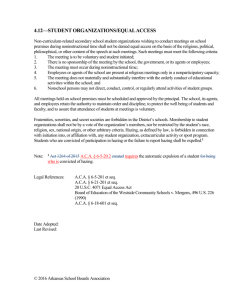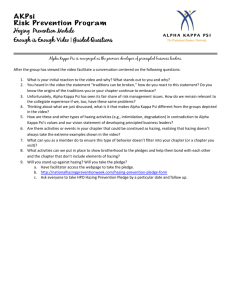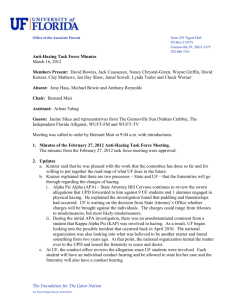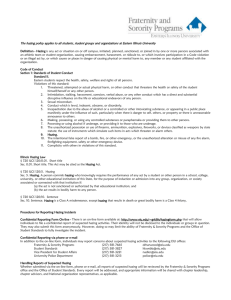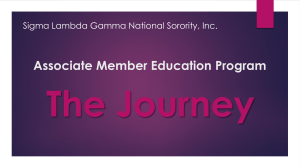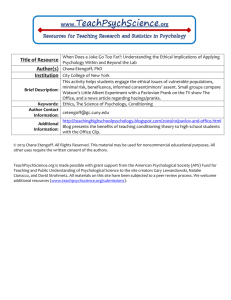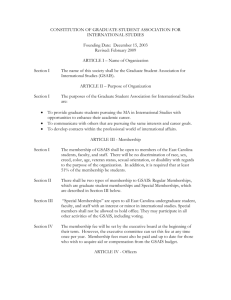Untitled - University of Maine
advertisement
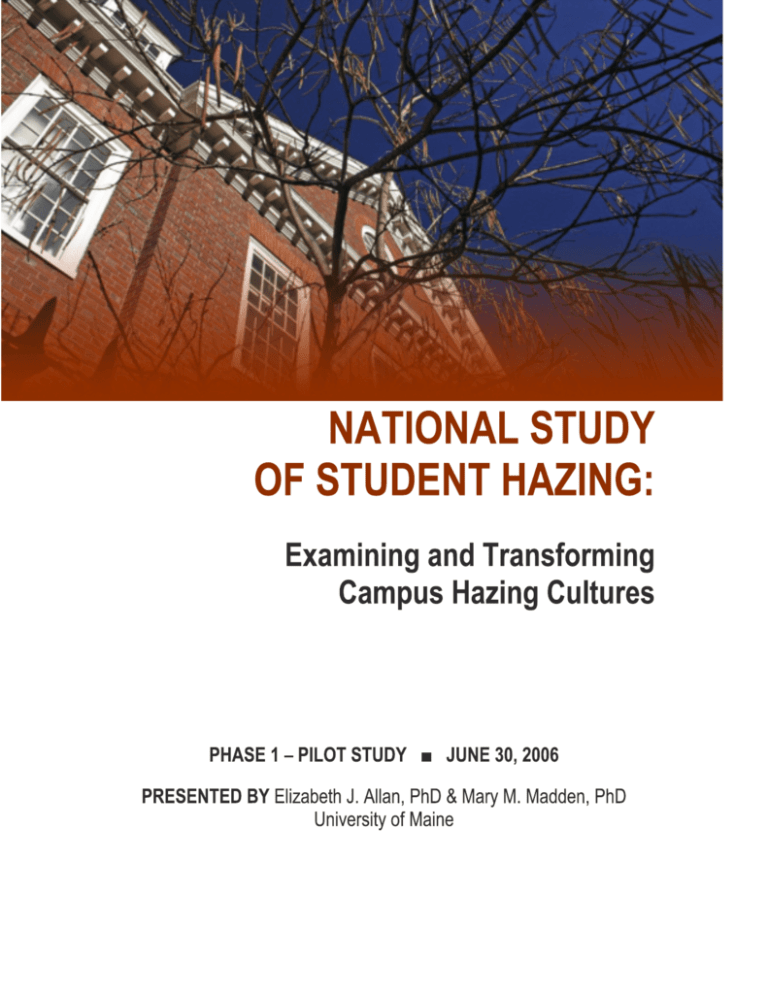
NATIONAL STUDY OF STUDENT HAZING Allan/Madden The data derive from surveys of students and interviews with students, staff, faculty, and administrators at four postsecondary institutions in the northeast region of the United States. This investigation represents the pilot study (Phase I) of the national study designed to examine hazing in colleges and universities throughout the United States. 2 NATIONAL STUDY OF STUDENT HAZING Allan/Madden The North American Interfraternal Foundation (NIF) and the NASPA Foundation provided start-up funding for the pilot phase of the national study on hazing in postsecondary education. As of May 2006, the following groups have joined this collaborative effort: • • • • • • • • • • 3 Alpha Phi Omega: a national, co-ed, service fraternity focused on college campus-based volunteerism for over 75 years. American College Personnel Association: ACPA fosters college student learning through the generation and dissemination of knowledge, which informs policies, practices and programs for the higher education community. Association of Fraternity Advisors: AFA is an international organization providing resources, recognition and support for campus fraternity/sorority advising professionals. Association for Student Judicial Affairs: ASJA facilitates the integration of student development concepts with principles of judicial practice in a postsecondary educational setting, and promotes, encourages and supports student development professionals who have responsibility for student judicial affairs. Center for the Study of the College Fraternity: The CSCF was formed in 1979 to encourage and support research of the highest quality and educational significance on the role of the fraternity and sorority in higher education. Fraternity Executives Association: FEA operates to further the common interests of member organizations by promoting, supporting, and encouraging the free discussion and exchange of ideas relating to college fraternal organizations. Kappa Alpha Order: National fraternity with 134 chapters at colleges and universities throughout the U.S. Kappa Delta: National sorority with 128 active collegiate chapters. National Association for Campus Activities: NACA links the higher education and entertainment communities in a business and learning partnership. National Association of Collegiate Directors of Athletics: The largest association of collegiate athletics administrators with representatives from more than 1,600 institutions throughout the United States, Canada and Mexico. Members include athletics directors, associate and assistant NATIONAL STUDY OF STUDENT HAZING Allan/Madden • • • • • • • • • • • 4 athletics directors, conference commissioners and affiliate individuals or corporations. National Association of Student Personnel Administrators: NASPA provides professional development, promotes exemplary practices, and is a leader in policy development in student personnel administration. National Collegiate Athletic Association: NCAA is a voluntary association of about 1,200 colleges and universities, athletic conferences and sports organizations devoted to the sound administration of intercollegiate athletics. National Consortium for Academics and Sports: The mission of the NCAS is to create a better society by focusing on educational attainment and using the power and appeal of sport to positively affect social change. National Intramural-Recreational Sports Association: Resource for professional and student development, education, and research in collegiate recreational sports. National Orientation Directors Association: NODA provides education and leadership in the fields of college student orientation, transition and retention. National Panhellenic Conference: An umbrella organization for 26 inter/national women's fraternities and sororities. Each member group is autonomous as a social, Greek-letter society of college women and alumnae. Members are represented on over 620 college and university campuses in the United States and Canada and in over 4,600 alumnae associations, making up over 3.6 million sorority women in the world. North American Intrafraternity Conference: advocate the needs of its 64 member fraternities through enrichment of the fraternity experience; advancement and growth of the fraternity community; and enhancement of the educational mission of the host institutions. Professional Fraternity Executives Association: The Professional Fraternity Executives Association (PFEA), is an organization that supports and enhances the development and professionalism of Professional Fraternity executives. Membership is open to full-time, paid chief staff executives of a professional Fraternity. Pi Beta Phi Fraternity: The mission of Pi Beta Phi Fraternity for Women is to promote friendship, develop women of intellect and integrity, cultivate leadership potential and enrich the lives of members and their communities. Professional Fraternity Association: The Professional Fraternity Association, Inc. supports professional fraternities and sororities, to preserve high standards on campus and in professional practice. Sigma Alpha Epsilon Foundation: The Sigma Alpha Epsilon Foundation is the tax-exempt fundraising arm of the SAE Fraternity with the motto “prepare, provide, preserve.” NATIONAL STUDY OF STUDENT HAZING Allan/Madden • 5 Sigma Nu Fraternity: National fraternity with chapters at colleges and universities throughout the U.S. NATIONAL STUDY OF STUDENT HAZING Allan/Madden A Research Advisory Group was established to inform and guide project design and assist with project funding. Members currently include (in alphabetical order): • • • • • • • • • • • • • • • • 6 Ms. Jessica Bartter, Communications Coordinator, Representing National Consortium for Academics and Sports (NCAS). Dr. Ron Binder, Associate Director of Residence Life for Greek Affairs, Bowling Green State University. Representing the Association of Fraternity Advisors (AFA). Ms. Martha Brown, Chair, National Panhellenic Conference (NPC). Mr. Mike Cleary, Executive Director, National Association of Collegiate Directors of Athletics Dr. Gwen Dungy, Exec. Dir., National Association of Student Personnel Administrators (NASPA). Dr. Danell Haines, Director, National Research Institute for College Recreational Sports & Wellness Ms. Debbie E. Heida, Vice President for Student Affairs and Dean of Students, Berry College. Dr. Terence Hogan, Dean of Students, Ohio University, Chair of NASPA Knowledge Community on Fraternity/Sorority Life. Ms. Andrene Kaiwi-Lenting, Assistant Director, Student Life and Leadership Coordinator, Orientation Programs at CalPoly. (NODA) Mr. Bob London, Board Member, Professional Fraternity Executives Association Mary Beth Mackin, Representing the Association for Student Judicial Affairs (ASJA). Dr. Richard McKaig, Vice Chancellor for Student Affairs & faculty member in Student Affairs & Higher Education, Indiana University. North American Interfraternal Foundation (NIF) Executive Board member. Mr. Hank Nuwer, nationally recognized hazing expert, author of three books on hazing, member of the advisory committee to the 1999 NCAA hazing study, Adjunct Professor at Indiana University-Purdue University and Faculty member at Franklin College (IN). Mr. John Ogle, Director of Education and Research, National Association for Campus Activities Dr. Laura Osteen, Director of Leadership Programs, Florida State University. Representing the American College Personnel Association (ACPA). Dr. Norm Pollard, Director, Counseling and Student Development Center, Alfred University. NATIONAL STUDY OF STUDENT HAZING Allan/Madden • • • • • • Dr. Judith Ramalay, Assistant Director of the National Science Foundation (NSF) and past-President of the University of Vermont. Dr. John Schuh, Distinguished Professor and Chair, Educational Leadership and Policy Studies, Iowa State University. Representating the National Association of Student Personnel Administrators (NASPA). Dr. William Smedick, Special Assistant to the Dean of Student Life, Johns Hopkins University, Representing the National Association of Campus Activities (NACA). Dr. Stephen Sweet, sociologist, statistician, and author of several articles about hazing, Professor of Sociology, Ithaca College. Ms. Mary Wilfert, Assistant Director of Education and Outreach, National Collegiate Athletic Association (NCAA). Ms. Louise Kier Zirretta, past President of the North American Interfraternal Foundation (NIF) and professional researcher. Elizabeth Allan, Ph.D. Principal Investigator Dr. Allan is an Assistant Professor of Higher Educational Leadership at the University of Maine. She has authored a number of articles, book chapters, and encyclopedia entries on the topic of hazing, and is the co-founder and manager of the educational website, www.StopHazing.org. Dr. Allan has been interviewed about hazing for a PBS documentary, for television, newspapers and radio shows throughout the country, and for periodicals including Sports Illustrated, TeenPeople, Glamour, Rolling Stone, British Cosmopolitan, Good Housekeeping and the Congressional Quarterly. Her research related to campus culture and climate has been published in the Harvard Educational Review (2003) the Maine Journal of Education (2004), Innovative Higher Education (2005), and The Journal of Higher Education (2006). Mary Madden, Ph.D. Project Director Dr. Madden is an Assistant Research Professor in the College of Education and Human Development at the University of Maine where she is a faculty member in the Center for Research and Evaluation with subject matter expertise in human development and gender equity issues in education. She teaches research and evaluation courses for graduate students at the University of Maine and is an expert in research design using both quantitative and qualitative methods and has designed and implemented numerous evaluation studies for K-12 schools, postsecondary institutions, and government agencies. She is currently 7 NATIONAL STUDY OF STUDENT HAZING Allan/Madden evaluating a youth suicide prevention project implemented in 12 Maine High Schools and funded by the Centers for Disease Control. Her recent research includes a study of classroom climate for undergraduate women and a study of social factors that contribute to and/or prevent girlfighting. Gustavo Burkett Project Intern At the time of the study, Mr. Burkett was a graduate student at the University of Maine in the Higher Educational Leadership M.Ed. program. Prior to his graduate work, Gus served as a Regional Director for Sigma Phi Epsilon fraternity for 30 campuses in the Midwest. Gus completed his M.Ed. in August 2005 and is now Associate Director of Student Activities and Greek Life at the University of Maine. Andrea M. Cole Project Associate Ms. Cole is currently the Coordinator of Academic Advising and Student Services in the College of Education and Human Development at the University of Maine. Previously, she held a five-year position as the Senior Associate with the National Center for Student Aspirations at the University of Maine. She is a former teacher at the elementary and middle school levels, as well as a coach and official at both the middle and high school levels. Cole has written and produced with Dr. Russell Quaglia three inspirational videos entitled Teaching Heroes. The three segments of the video package are Coaches: Making a Difference; Parents: Inspiring Your Child from the Sideline; and Student Athletes: A Commitment to Citizenship. Cole has both her Bachelors degree (Elementary Education, ’97) and Masters Degree (Student Development in Higher Education, ’04) from the University of Maine. She was awarded UMaine’s Greek Lifetime Award in 2001 and the Outstanding Advisor Award in 2005 for her direct service to Chi Omega Fraternity and the greater Panhellenic Community. 8 NATIONAL STUDY OF STUDENT HAZING Allan/Madden Unfortunately, many students and professional staff in colleges and universities remain uninformed about the realities of hazing. Stereotypes shape perceptions of hazing as only a problem for Greeks and athletes and/or simply harmless antics and pranks. These views are shortsighted and may jeopardize the health and safety of students affected by hazing in other arenas, and hinders the overall quality of the learning environment in schools and postsecondary institutions. Despite the documented problems related to hazing, scholarly attention to the issue remains relatively scant. The most extensive empirical data regarding hazing practices were generated from the Alfred University/NCAA study on college athletes (1999). Other accounts of hazing have been provided by author/journalist Hank Nuwer (1990, 1999, 2000) and a number of thesis and dissertation studies have focused on hazing in the context of Greek life (Holmes, 1999; Lowery, 1998; Shaw, 1992) and athletics (Johnson, 2000). The StopHazing.org website receives daily email queries from students who have been involved in hazing activities. Many of these include accounts of hazing among marching bands, theatre groups, ski clubs, church groups, club sports, freshman camp, orientation groups, residence living units and other social and academic clubs. Such reports range in nature and severity, but commonly include forced and/or coerced consumption of alcohol, sexual simulations, ingestion of vile substances, personal servitude, public humiliation, sexual assault, and participation in theft and other illegal activities. 9 NATIONAL STUDY OF STUDENT HAZING Allan/Madden The study will provide foundational data from which to assess campus climates and inform best practices for hazing intervention and prevention. It also aims to generate breadth of knowledge and promote more in-depth understanding about hazing with possible applications to other populations. More specifically, the goals of this research are to: Investigate the prevalence and nature of hazing behaviors among students in U.S. colleges and universities. Offer research-based strategies for responding to and preventing the problem of hazing among college students with transferability to middle and secondary schools. In 2005, the North American Interfraternal Foundation (NIF), with support from the NASPA Foundation and other collaborating partners, provided funding for the development and implementation of Phase I—a Pilot Study for this investigation. The pilot study exceeded expectations and yielded numerous gains including the development of reliable data collection instruments and analysis procedures, testing sampling strategies, and generating data from both surveys and interviews. 10 NATIONAL STUDY OF STUDENT HAZING Allan/Madden Data for the pilot study data collection were collected from March – May, 2005 with students and staff at four post-secondary institutions in the Northeastern United States. Data collection consisted of a web-based survey for students and interviews with students, staff, and administrators at each campus. Participating institutions included a small private college as well as larger public universities. Full-time undergraduate students under the age of 25 were the target of the web-based survey. Each institution generated the student sample for the study. 11 NATIONAL STUDY OF STUDENT HAZING Allan/Madden An invitation to participate in the survey was sent to students via email which provided a code and hyperlink to access the web-based survey. Students who completed the survey were entered into a drawing for one of fifty $10 iTunes gift certificates. The survey consisted of 70 questions and was designed so participants could respond to 70 questions 99% completion rate 1,789 total respondents 66% female 86% white 69% on-campus residents these questions relative to three distinct membership groups. For example, a student belonging to a varsity team, a fraternity, and an academic club would respond to the set of questions for each of these activities separately. Ninety-percent of the students who accessed the web-based survey completed it. In all, 1789 full-time undergraduate students under the age of 25 who belonged to a student activity responded to the survey. Two-thirds of the respondents were female and one-third male. Eighty-six percent of the respondents identified their race/ethnicity as White. Sixty-nine percent of the students lived on-campus. Students responding to the survey reported they belonged to the following student groups: 12 24% - recreation or club sports teams 14% - academic club 15% - honor society 11% - social fraternity or sorority 10% - varsity athletes 10% - band or other performing arts organizations 05% - service fraternity or sorority 02% - ROTC or other military organization 22% - do not participate on teams or in organizations NATIONAL STUDY OF STUDENT HAZING Allan/Madden Face-to-face interviews were conducted with 90 individuals at the four campuses. Participants included student leaders, student affairs and athletics staff, and senior student affairs officers. At each campus, project staff worked with a student affairs staff member to select interviewees and schedule the interviews. The staff members were given a list of staff positions and student organizations from which to recruit individuals for the interviews. Interviews were 30-60 minutes in duration and were audio-taped and later transcribed for analysis. This study provided the opportunity for researchers to test sampling strategies and data collection instruments. It also provided insights into hazing that will be further investigated in the national study. This report shares the findings of the pilot study. The researchers wish to remind readers that the sample in this pilot study was limited and therefore, caution is urged in generalizing finding or drawing broad conclusions. 13 NATIONAL STUDY OF STUDENT HAZING Allan/Madden As we learned during the interviews, many students associated hazing with fraternities and sororities explaining, “My interpretation was that you have a fraternity or sorority where you have to do rushing and things to prove you want to be there.” Yet the survey showed that students who were members of different types of student groups reported experiencing hazing behaviors. Students were given a list of behaviors and asked if they had experienced any of the behaviors in the process of joining or maintaining membership in a student organization or team. The following is a partial list of the behaviors: 14 Attend a skit night or roast where other members are humiliated Sing or chant by yourself or with a few select team members in a public situation that is not related to the event, game, or practice Wear clothing that is embarrassing and not part of the uniform. Be yelled, screamed, or cursed at by other team/organization members Get a tattoo or pierce a body part Act as a personal servant to other members Associate with specific people and not others Deprive yourself of sleep Be awakened at night by other members Make prank phone calls or harass others Be tied up, taped, or confined to small spaces Be transported to and dropped off in an unfamiliar location Endure harsh weather without the proper clothing Make prank phone calls or harass others Drink large amounts of a non-alcoholic beverage such as water Participate in a drinking game Drink large amounts of alcohol to the point of passing out or getting sick Watch live sex acts Perform sex acts with the same gender NATIONAL STUDY OF STUDENT HAZING Allan/Madden Perform sex acts with the opposite gender Keep a tally of men or women with whom you have had sex Among all respondents, the most common behaviors reported by students were as follows: - Participate in an alcohol-related drinking game - Sing or chant by self or with other selected group members - Endure harsh weather conditions without proper clothing Deprive self of sleep - Yelled, screamed, or cursed at by other group members - Be awakened during night by other group members The study also examined hazing behaviors according to membership groups. The following graphs illustrate the behaviors, and the percent of respondents who say they participated in the specific behaviors in order to join or maintain membership in particular types of student groups including: varsity athletics, social fraternities and sororities, recreation and sports clubs, and band and performing arts groups: 15 NATIONAL STUDY OF STUDENT HAZING Allan/Madden 70% 60% 50% 40% 30% 20% 10% 0% 16 NATIONAL STUDY OF STUDENT HAZING Allan/Madden 70% 60% 50% 40% 30% 20% 10% 0% 17 NATIONAL STUDY OF STUDENT HAZING Allan/Madden 25% 20% 15% 10% 5% 0% 18 NATIONAL STUDY OF STUDENT HAZING Allan/Madden 70% 60% 50% 40% 30% 20% 10% 0% 19 NATIONAL STUDY OF STUDENT HAZING Allan/Madden 70% 60% 50% 40% 30% 20% 10% 0% Some hazing behaviors were more common among certain student groups than others. The following graphs illustrate the percentage of students from varsity athletics, social fraternities/sororities, service fraternities/sororities, recreation and sports clubs, and band and performing arts groups that reported experiencing the common hazing behaviors. 20 NATIONAL STUDY OF STUDENT HAZING Allan/Madden Band Recreation Clubs Service Fraternities/Sororities Social Fraternties/Sororities Varsity Athletics 0% 10% 20% 30% 40% 50% 60% 70% % of Students in Activity Reporting Behavior Band Recreation Clubs Service Fraternities/Sororities Social Fraternties/Sororities Varsity Athletics 0% 10% 20% 30% 40% 50% 60% % of Students in Activity Reporting Behavior 21 70% NATIONAL STUDY OF STUDENT HAZING Allan/Madden Band Recreation Clubs Service Fraternities/Sororities Social Fraternities/Sororities Varsity Athletics 0% 10% 20% 30% 40% 50% 60% 70% 60% 70% % of Students in Activity Reporting Behavior Band Recreation Clubs Service Fraternities/Sororities Social Fraternities/Sororities Varsity Athletics 0% 10% 20% 30% 40% 50% % of Students in Activity Reporting Behavior 22 NATIONAL STUDY OF STUDENT HAZING Allan/Madden Band Recreation Clubs Service Fraternities/Sororities Social Fraternities/Sororities Varsity Athletics 0% 10% 20% 30% 40% 50% 60% 70% % of Students in Activity Reporting Behavior The following, which are examples from different students who willingly described their hazing experiences during the interviews, provide a glimpse at the ways in which hazing can range from degrading to physically harmful and dangerous: …spit containers saved all semester with anything they could find to be disgusting…we had to soak our clothes in it and wear them to class, no showers, it was really rough…” [We did] “very sexual things…licking a banana covered in ‘human chocolate sauce’ and not giving people a choice of whether or not to do it.” “Everyone hazes the hell out of you [during hell week]…I didn’t really tell anyone the full extent…there’s a lot of things you’d just rather forget.” “Being a freshman and totally intoxicated…I ended up in the woods and fell and cut my leg. I had to call a friend from a gas station. I still have a scar [3years 23 NATIONAL STUDY OF STUDENT HAZING Allan/Madden later]…It was supposed to build team unity…but they [teammates] were not there for you at the end of the night.” “I knew it was my time to get picked on and eventually it would stop and be someone else’s time to get picked on…there were tons and tons of beat downs…in the locker room.” “I was hazed my first year…I said, ‘I’m not drinking anymore’ so they hit me. I wound up taking 7 shots of 151 and had never drank hard alcohol before. It was terrible.” “His goal was to completely demolish and demoralize us…At one point the axe handle slipped and it smashed someone in the skull.” “It was really rough, I’m surprised someone didn’t die of alcohol poisoning that night.” “I broke my hand in two places, the pledge educator told me…to say it was something else.” Students were given the following definition of hazing: “Hazing is any activity expected of someone joining or participating in a group that humiliates, degrades, abuses, or endangers them regardless of a person’s willingness to participate.” 24 NATIONAL STUDY OF STUDENT HAZING Allan/Madden They were then asked if they had ever been hazed at the postsecondary institution they currently attend. One in 20 students reported they had been hazed. However, when given a list of specific behaviors, which would meet the definition of hazing, more than one in five students say they have experienced some of these behaviors while in college. While students reported experiencing behaviors which meet the criteria for hazing, many do not consider themselves to have been hazed. Students often defended their participation in the behaviors by claiming to have participated willingly. They provided such explanations as “nothing happened to me that I did not agree to” or “it was all in fun.” When asked in interviews to share their definitions and understandings of hazing, students often equated hazing with physical force and a lack of willingness. As this student said, hazing is “a power thing … forcing people to do things they don’t want to do.” Students most often failed to recognize the role of group coercion and the difficulty of truly consenting when faced with powerful peer pressure. For those who are willing to acknowledge that their experience constitutes hazing, they may be deterred from reporting their experience because of peer reaction and/or retribution. As this student explains, “I don’t know anyone I could go to [to talk about hazing]…I don’t think there is anyone you could really turn to. If you turned to your coach and your team finds out, then good luck dealing with your team.” 25 NATIONAL STUDY OF STUDENT HAZING Allan/Madden Forty percent of the students who reported being involved in hazing behaviors report that a coach or organization advisor was aware of the activity. Twenty-two percent report that the coach or advisor was involved in the hazing: 26 NATIONAL STUDY OF STUDENT HAZING Allan/Madden 27 NATIONAL STUDY OF STUDENT HAZING Allan/Madden Despite the existence of hazing at postsecondary institutions, only 28% of respondents say they were told about anti-hazing policies when joining a team or student organization, and only 22% say they were given a written copy of campus policies. For some students, warnings about hazing activities were vague. This student described the perspective of many students we interviewed: “you are never really taught specifically [what hazing is], but just told that you can’t do that because it is hazing and you’ll get in trouble.” Hazing extends beyond those who experience the actual behaviors. Two out of every five students say they are aware of hazing behaviors occurring within teams and student organizations on their campus. More than one in five report that they witnessed these hazing behaviors. 28 NATIONAL STUDY OF STUDENT HAZING Allan/Madden Many students come to college having experienced hazing. Given the following definition, “Hazing is any activity expected of someone joining or participating in a group that humiliates, degrades, abuses, or endangers them regardless of a person’s willingness to participate” 1 in 20 students say they have been hazed in college. Twice as many, 1 in 10 students, say they were hazed in high school. This was a pilot study conducted in preparation for a larger national study. The study is limited by the following factors: 29 Small number of participating institutions Lack of geographic diversity among these institutions Lack of racial and ethnic diversity among respondents Continue to analyze the data collected during the pilot; Refine the survey instrument and interview protocols; Identify and recruit post-secondary institutions to participate in the study; Collect survey and interview data; Analyze data; and NATIONAL STUDY OF STUDENT HAZING Allan/Madden Develop research-based strategies for prevention of and intervention in hazing. 30
